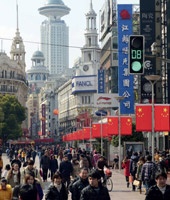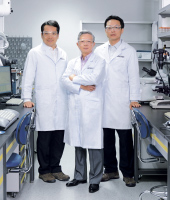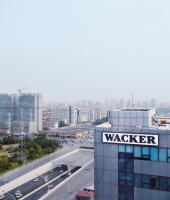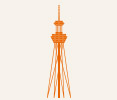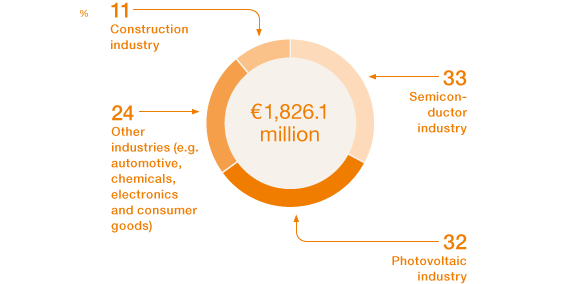Introduction
We are seeing the dawn of a new age, as the world’s economic axis tilts from west to east. The 21st century is the century of Asia. And Europe, too, will benefit. German innovation leaders, in particular, are finding new partners and markets in the growth centers of the Far East.
With enough confidence and hard work, you can realize any dream – at the beginning of the 21st century, this core idea of the American Dream now also encapsulates the Chinese Dream. At the easternmost tip of China’s coastline, a city is springing up that embodies this optimism and faith in the future. Just a handful of sleepy fishing villages ten years ago, Lingang New City is being built to a grand plan by the Hamburg architect Meinhard von Gerkan. This model city for 800,000 residents from the creative class will soon come to life as a venue for education and research facilities, and trade and conference centers. “Our dream is to create China’s preeminent city of the future,” says Gu Xiaoming, one of the leading officials involved in the construction of this new, planned city. From Lingang on the outskirts of Pudong district, Shanghai’s commercial center, a 32-kilometer six-lane bridge leads to the deepwater harbor of Yangshan, part of the port of Shanghai, the biggest container hub in the world.
Lingang’s roads are still almost empty, as only about 60,000 people live there. A rare snapshot in the new land of unlimited possibilities: “I remember when Pudong was still just fields, and we were shown a city planning model with numerous skyscrapers, parks and other facilities,” said Mark Mobius, a fund manager specializing in emerging countries. “It seemed like an impossible dream at the time. But now the dream has become reality here in Pudong.”
Dreams can come true in Lingang, too. Almost all the apartments that have been built have already been sold. The owners are waiting for the city to be completed, which is expected by 2020. An important step was taken in December 2013, when Lingang was connected up to the Shanghai metro. A free-trade zone had already been created in Pudong in September 2013, reminiscent of Deng Xiaoping’s special economic zones, the nuclei of the Chinese economic miracle triggered by the 1978 reforms.
Lingang symbolizes China’s two key development focuses over the last three decades – urbanization and economic boom. Both are taking place on a scale and at a pace that take your breath away. The number of city dwellers rose from 172 million in 1981 to over 700 million in 2013. In the coming decade, a further 300 million Chinese, so it is predicted, will move into cities that didn’t exist until recently. China develops a floor area the size of the whole of Germany every two years.
Since 1978, the annual per capita income has increased thirtyfold to US$ 6,000. China overtook Germany as the world’s biggest exporter in 2009 and Japan as the second biggest economy a year later. Now, three of the ten companies generating the most revenue in the world are from China, more than from Japan or the USA. The Fortune Global 500 list of the world’s biggest companies included 34 Chinese companies five years ago, now there are 89. According to a study by management consultancy PricewaterhouseCoopers, China will overtake the USA as the world’s leading economic power in only three years.
“China as a whole has now become a single special economic zone,” wrote the former German Chancellor Helmut Schmidt in his new book “Ein letzter Besuch – Begegnungen mit der Weltmacht China” (A Last Visit – Encounters with the World Power of China; not yet available in English). The country is now continuing the process started by Japan in the 19th century, of overtaking western countries in science and economy and in standards of living within a few decades. China is passing through evolutionary stages at breakneck pace, or skipping them altogether.
In November 2013, the Communist Party made a decision to establish more free-trade zones in order to stimulate domestic demand and give the market a “decisive” role in the Chinese economy. Though cooling off somewhat, China’s growth is becoming more sustainable, less export-dependent, more innovation-led and of higher quality. For example, its major cities are already connected by 10,000 kilometers of high-speed train lines, more than in the whole of Europe. Another 10,000 kilometers are planned. China now builds its high-speed trains itself. They cover the 2,300-kilometer direct route between Beijing and Guangzhou in about eight hours, at an average speed of nearly 300 km/h.
Increasing domestic demand and growing standards of living among the middle classes in China are stimulating demand for high-quality products.
The way Chinese companies are climbing the quality ladder can be demonstrated with two wrecked cars. It is now five years since a model by the Chinese manufacturer Brilliance was smashed to pieces in the crash test – zero stars out of five. When a model by the new Qoros brand from Shanghai was tested in fall 2013, it achieved the top grade, even surpassing the VW Golf. The “Made in China” label will go the same way as “Made in Japan” and “Made in Germany” before it – developing from a warning sign to a badge of quality.
China is more and more in the “mid-luxury” range in terms of both its manufacturers and consumers. Since 2012, China has been the most important market for BMW, Audi, Mercedes and Porsche. The four brands sold over 959,000 new cars here – more than nine times as many as in 2005. The Chinese already buy more luxury goods than the Europeans or Americans, sometimes even purchasing the company that makes them. Volvo from Sweden, the Italian yacht manufacturer Ferretti and the Swiss watch brands Eterna and Corum are all owned by the Chinese.
Wages and living standards are rising – and therefore manufacturing costs, too. Unable to afford high er labor costs, increasing numbers of companies are switching to automated production. The Apple contract manufacturer Foxconn, which employs over a million people in China, intends to bring several hundred thousand robots on stream in the coming years. The workshop of the world is moving on – to Vietnam and Indonesia, Cambodia and Bangladesh.
The boom emanating from China has sent ripples across Asia. It will tilt the 21st century’s economic axis from west to east. Seven of the ten biggest metropolitan regions are already in Asia – there were only four in 1980. And where are the ten biggest container ports in the world? Seven are in China; one is in Singapore and one in South Korea. Where are the most innovative countries? In 2011, half of all patent applications came from Japan, South Korea and China. “We are now witnessing a historic transformation, which, though still at an early stage, is destined to change the face of the world,” wrote the British journalist Martin Jacques in his bestseller “When China Rules the World.”
This change is particularly apparent among the ten member states of the Association of Southeast Asian Nations (ASEAN). Malaysia, Singapore, Indonesia, the Philippines, Thailand, Cambodia, Laos, Vietnam, Myanmar and Brunei currently make up the fastest growing economic region in the world.
From a developing country to a high-tech nation: South Korea is the world market leader in cellphones, memory chips and liquid crystal displays.
In the past six years, ASEAN’s GDP has doubled to about US$ 2,500 billion. That could be repeated in the next six years, according to economic information provider IHS.
The planned free-trade zones could be the turbochargers for this growth rally. ASEAN should be an integrated economic area by as early as 2015. Negotiations for another free-trade agreement are already underway between the ASEAN states and their Asia-Pacific neighbors Australia, China, India, Japan, New Zealand and South Korea – an economic area of over three billion people. This development is being driven by two markets akin to giant rising suns: China and India. But they are accompanied by a constellation of stars that, though smaller, are also growing strongly.
The direction Asia is taking can already be charted: after its independence in 1965, Singapore evolved into a tiger state. Within a few decades, this developing country had shrugged off its mass unemployment and developed into one of the wealthiest, most modern societies in the world, thanks to an economically innovative, albeit politically authoritarian brand of state capitalism and a tough crackdown on corruption. One young lady who embodies this rise is 31-year-old Daphne Tang. “My grandfather emigrated to Singapore from the southern Chinese province of Guangdong. He had nothing at all, and, in his new homeland, offered himself for hire as a construction worker.” Daphne Tang’s father became a cook in a roadside restaurant. She herself studied information science and gained a job as a senior application consultant at NCS, Singapore’s biggest IT service provider.
When independence was gained in 1965, Singapore’s gross national product was just US$ 1 billion; in 2012, it was US$ 277 billion. Singapore now has one of the highest per capita incomes in the world. No other state has such a high concentration of millionaires. There are only two casinos, but in 2012 they turned over about US$ 6 billion, more than all the casinos of Las Vegas together. The infrastructure and level of education are exemplary. In the current Times ranking of the best universities, the National University of Singapore comes 26th. The best German university, LMU Munich, comes 55th. Prime Minister Lee Hsien Loong announced that the port, the second biggest in the world with some 30 million metric tons of container trade per year, will be shut down in the near future. A new port over twice the size will be constructed at a different location. There are also plans to build a high-speed rail connection – 330 kilometers, 90 minutes – to the Malaysian capital of Kuala Lumpur.
The emerging Asian cities model themselves on Singapore and are trying to implement the economic development measures that were so successful there. Singapore is even contributing to the development of some Chinese cities, such as the Industrial Park in Suzhou or Knowledge City in Guangzhou, an urban planning vision for South China’s transition from workshop to knowledge society in the medium term. Malaysia, too, from which Singapore once gained its independence, is facing a leap in development toward a knowledge-based and innovation-driven economy. In the global ranking of competitiveness published by the World Economic Forum each year, it is already ahead of Ireland, Spain and Italy.
Another beacon of the new Asia is South Korea. Like Singapore, the country only made the leap to an industrial and eventually IT and innovation-led economy thanks to farsighted state capitalism and iron discipline. Here, too, knowledge was seen as the most valuable raw material, and therefore education was considered the principal task of the state. Important past and present South Korean players are the chaebols – large, often family-controlled business conglomerates with strong ties to the state, such as Samsung, LG Electronics and Hyundai, who export all around the world.
US President Barack Obama frequently cited the country as a role model for developing countries: “When my father came to study in the United States, Kenya had a higher standard of living than South Korea.” That was in 1959. The per capita income of South Korea is now 18 times that of Kenya. South Korea is the first country to rise from a recipient of OECD development aid to become one of its donors. The country is a world market leader in cellphones and memory chips. In shipbuilding, too, and the production of LCD displays, South Korea bestrides global markets with shares of 51 percent in each case. Samsung Electronics, founded in 1969, has become the biggest electronics corporation in the world.
However, the country still isn’t resting on its laurels. A structural change can currently be observed in South Korea – if China is reinventing itself, then its neighbor must follow suit. In the automotive, electronics and telecommunications industries, for example, Chinese manufacturers will be playing an ever more important role in the foreseeable future, backed up by a huge domestic market. South Korea’s new growth industries include biotechnology, medical engineering, nanotechnology and batteries for electric cars.
India has still not seen developments like those in South Korea, Singapore and China, despite some impressive growth rates of over 9 percent in recent years. The main bottlenecks are proliferating bureaucracy and an inadequate infrastructure, causing India to have paused for breath in the past two years, while its economy has only grown by about 5 percent annually.
It is remarkable how well the country has developed, despite the modest infrastructure. In an analysis, the HSBC bank astonishingly found that India had “managed to achieve growth without the infrastructure focus of other Asian countries.” But the government’s current five-year plan now provides for an injection of some US$ 1,000 billion into the country’s infrastructure by 2017. Probably the most ambitious single project is the 1,500 kilometer-long Delhi-Mumbai Industrial Corridor linking the political capital city of Delhi to Mumbai (India’s economic center) with a high-speed rail line. Some 24 new cities are to be built in the corridor – modern, environmentally friendly and carefully planned with excellent transport links and broadband internet connections.
Raghuran Rajan, the head of India’s central bank, believes that his country will soon pick up speed and surpass China’s rates of growth. “India only has to exercise the same discipline that the Chinese have shown in expanding their infrastructure.” There are grounds for optimism in their very low per capita income compared to China, a relatively young population with growing consumer power and a high level of education among the aspiring middle class numbering some 300 million people.
India’s economic output is currently half that of Europe, and, according to the OECD, will close the gap with Europe by 2030, and be twice the size by 2060. This year, India will surpass the USA as the biggest user of the internet after China. By 2020, it will probably be the third biggest car market in the world, behind China and the USA.
Thus the Asian century is well underway. For Europeans, too, the “Far” East has drawn much closer. Large parts of German industry would no longer be viable without the markets in East, Southeast and South Asia. Volkswagen already talks of China as its “second domestic market.” The German economy breaks record after record – in October 2013, alone, goods valuing € 99.1 billion were exported, more than in any previous month. A good part of that is due to the growing interest of Asian client industries, customers and partners.
German companies face new competitors as ever more Asian companies move up the value-creation chain. However, Germany’s most important export goods – machinery, cars and chemical products – are in strong demand in Asia. Between 1990 and 2012, the Asian share of Germany’s exports grew from 7.1 percent to 13 percent. This development is likely to continue provided that German companies maintain their role as innovation leaders and guardians of quality, since they are the most important equippers of the Asian boom. France is still Germany’s most important bilateral trading partner. But, according to a recent study by the Oxford Economics research institute, China will take on this role by 2030 at the latest.
